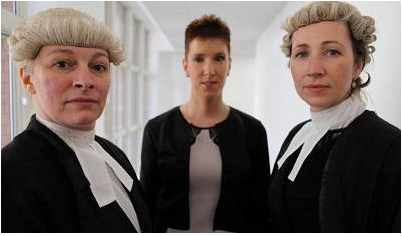On Wigs, Websites, Women and Whiteness

Dr Andrew Gilbert from the OU Law School shares his findings on 'Wigs, Websites, Women and Whiteness' in our latest blog post.
I used to think that law schools were obsessed with featuring on their websites images of students wearing wigs and gowns. Recently, whilst researching for another project which meant I visited 116 UK law school websites, I thought it would be an excellent opportunity to also assess just how common horsehair headwear is in law school marketing and, perhaps more importantly, what are the gender and ethnicity of those depicted.
116 websites later, to my surprise only 21 of them (18%) carried photos of students enrobed and bewigged. I’ll put this in context. 16,256 students graduated with law degrees from English and Welsh universities in 2018. In 2018-19, 1,021 students successful completed the Bar Professional Training Course and in the same year 568 people commenced the first six of a pupillage. It’s a crude calculation but there is clearly a considerable mismatch between 2,926 (18% of 16,256) and the 568 who go on to actually don wig and gown in a real courtroom. So even though the prevalence was less than I thought it would be, the representation of students as barristers does exceed the actual number who go on to do it for real by a multiple of about five. And even then – although this discussion is for another time – the representation of barristers as dressed in court attire reflects the working lives of a minority of barristers or perhaps of a bigger proportion but for a minority of the time.
I was also interested in who was in the images, i.e. were they male or female, white or people of colour.* It turned out that 42% were male, 58% female; 73% white, 27% people of colour. Again, it’s interesting to put these figures in context. According to the Bar Standards Board, 38% of barristers are female (compared to 50.2% of the UK working age population), and 13.6% are Black, Asian and Minority Ethnic (against 14.4% of the working age population in England and Wales). So when it comes to dressing in wigs and gowns, law school websites tend to represent women and people of colour to a greater extent than is actually the case at the Bar and in the working population. I’m left doubly pleasantly surprised: law school websites aren’t as obsessed as I thought and they are more progressive than I had expected. As well as increasing the diversity of its members, maybe now the Bar should take a further progressive step: spare the horses and do away with wigs altogether.
*I realise that ethnic descriptors are contested. I didn’t feel able to judge someone’s specific ethnicity (e.g. black, Asian) from a photograph and didn’t want to use ‘non-white’ because it privileges whiteness and defines others by what they are not. I appreciate that some might find the term ‘people of colour’ problematic.

